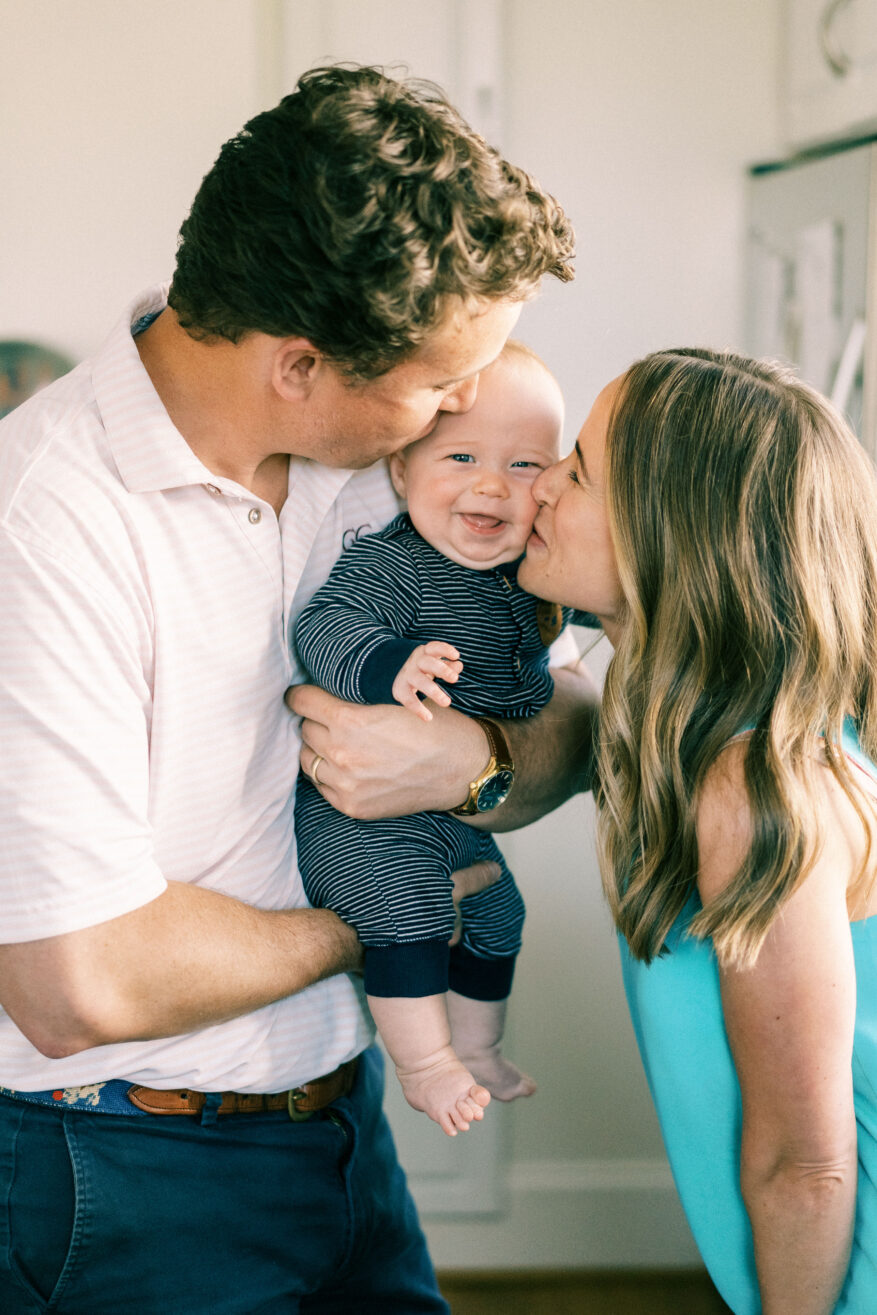


A baby sleep consultant shares how to get your baby on a schedule that’s appropriate for his or her age.
If you followed me on Instagram this past fall, you know that my newborn, Thomas, was a TERRIBLE sleeper. He rarely slept more than 30 minutes at a time. It’s always rough with a newborn, but we don’t have family close by to help and we wanted ti keep everyone super healthy, which prevented friends from stepping in. I was in the hospital for 5 days so I came home very sleep deprived and then I rarely slept more than 3 hours a night for nearly 3 months. And I’m NOT a person who can nap. Since I work for myself, I didn’t get a true maternity leave so I was stressed about work as well, even though I have a fantastic blog team and Beautycounter team. On top of it all, I also dealt with pretty severe postpartum depression and anxiety, which was exacerbated by sleep deprivation.
All the newborn books in the world couldn’t improve Thomas’ sleep. Nothing on my baby registry could fix it, not even the-supposedly magical Snoo. (which turns out, we HATED.) He wouldn’t even sleep in the car or in the stroller. I bought multiple sleep programs and read countless articles online. Nothing. Helped. I’m sure so many of you can relate.
We finally hired postpartum doulas to help and eventually hired a sleep coach, Molly from Sleep Shore. We started working with her at 8 weeks to try to make some improvements (there’s only so much you can do at that age!) and again at 16 weeks. At that point, our lives completely changed.
Now Thomas falls asleep on his own and if he wakes up, he puts himself back to sleep. Sometimes I actually have to WAKE him up so he doesn’t sleep too long and mess up that night’s sleep. He smiles when we put him in his crib and he’s so happy when he wakes up. He’s more cheerful when he’s awake and almost never cries now. I’m telling you, it’s like a different baby.
And I feel like a different person too. Actually, I feel like myself again. I have more energy, I’m happier, I can work out, I can focus when I work, and I’m a better mom and wife. And what’s HUGE for me is that I’m almost never anxious around nap time and bedtime. And if a nap or a day doesn’t go as planned, I know how to pivot to redeem the day and night’s sleep as best as possible.
My husband and I are incredibly grateful for her every single day and I can’t encourage you enough to hire Molly if you can relate to any of the struggles we had. Sleep Shore works with newborns all the way up to nine years old, so it’s not too late to improve your little’s ones sleep!
Okay, enough about our experience. Today, Molly, our amazing sleep coach, is here to share how to get your baby on a better sleep schedule. If you decide you’re ready to improve your kiddo’s sleep too, use this link with code Teri for 10% off a Sleep Shore sleep plan.
Over to you Molly!
If you were anything like me as a new parent, you thought your newborn would sleep all the time, day and night. They’d go to bed easily and nap for hours at a time, right? WOAH was I wrong! As a newborn and young infant, my son would not fall asleep for naps and got stuck in a constant overtired cycle which made it impossible to get him to fall and stay asleep.
Fast forward to when he was 3 months old when I had my first consult call with a sleep coach. I’ll never forget when she said, “He should only be awake for 60-75 minutes before going back down for a nap”. I had ZERO clue about wake times and once I started following an age appropriate schedule, the nap and bedtime struggles got a lot easier! So, let’s talk about ways you can create a sleep schedule for your baby.
As much as parents would like to set their children’s schedules, I’m here to break the news that babies’ sleep schedules and rhythms are predisposed based on age and circadian rhythms. You can’t force them on your schedule. So, as a starting point, use the below wake time and nap guide based on your baby’s age.
Disclaimer, this is a guide, every baby has individual, specific sleep needs. This is where a sleep coach comes in. We work with families to track and analyze YOUR baby’s sleep needs because one 5-month old’s schedule and sleep needs is different from another 5-month old! Sleep is scientific and complex. You don’t have to be a time tracker all on your own!
To encourage a sleep schedule, your baby’s naps should take place in a consistent sleep environment. The best and more restorative naps take place on a flat surface, a bassinet or crib, and in a room that is DARK and cool. Let me get on my dark room soap box, I’m talking DARK people, you shouldn’t be able to see your hand when the lights are off, and blinds are closed on the brightest of days. Any bit of light that comes into the room during sleep and hits your baby’s eyes can stop melatonin production (the sleepy hormone). Just make it pitch black, deal??
White noise is crucial to help block out daytime sounds and to help mimic the sound of the womb. And you really should test this. When I was working with Teri on Thomas’ sleep, she thought the room was pitch black. I asked her to send me a photo and she quickly realized all the light that was peeking in from the windows. There should be NO light. She eventually covered her windows up with black trash bags and then covered those with her blackout curtains. Yup. Trash bags not your style? I like these window coverings too. (Safe sleep tip: There shouldn’t be ANYTHING in the crib when your little one is sleeping! It’s fine for a cute photo but always take any stuffed animals out before naps and bedtime.)
Crib | Rug | Wall Decals
Naps and overnight sleep take time to consolidate. Naps typically consolidate between 4-6 months on average. Typically, the first nap of the day is the first one to extend. Sleep, especially independent sleep, is a hard skill to learn. Your baby was likely held or assisted to fall asleep for the first few months of life. And that’s okay! But when you start to work on a schedule and naps, don’t give up if, after a few days, it feels like you’re not getting anywhere. Getting on a good, consistent schedule can take weeks!
Your baby might have a great nap one day, but not the next—and that’s normal. Don’t stop giving your little one the opportunity. You’ll see progression, but, as with all milestones, it’s usually two steps forward, and one step back. And PLEASE don’t compare your baby to your friends. Babies are different, and they reach different sleep milestones at different times.
Lastly, feeding plays a huge role with sleep, whether you’re breastfeeding or using formula. Ensure your baby is getting the appropriate number of feedings or ounces based on their age. Just like sleep, babies feeding needs are individual and specific. If you are following a specific feed schedule and you’re finding that your baby is hungrier, then you may need to rethink the number and timing of feeds your offering your baby! Figuring out feeding was HUGE in Thomas’ progression too!
Common mistake! Some parents think if they keep their baby up longer, they will sleep longer (guilty of thinking this as a new mom!) – big no, no! This will cause your baby to get severely overtired and likely get to the point where they can’t fall asleep or can cause multiple wake ups. Thomas was up wayyyyy too late – one of the first things I worked with Teri on was getting him down for bed much earlier in the evening.
I’ll say it once, I’ll say it again, sleep needs and times are predisposed based on age. Don’t go against those natural rhythms. If you have tried following wake times and a schedule is just not happening, call in the experts!
At Sleep Shore, we believe in utilizing science, data, and empathy to help parents teach their children how to become independent sleepers. When children sleep better, parents do too! And we can help get your baby on a solid schedule and help get your your newborn, infant, toddler or school-age child to sleep an extra hour or sleep the entire night.
Use code Teri10 for 10% off with this link to work with me!
And follow me on Instagram for more sleep tips!
The American Academy of Pediatrics recommend the ABCs of safe sleep:
ALONE – while the AAP recommends room sharing, they also recommend a separate sleep space for the baby.
BACK – always place your baby on her back for sleep and be sure the surface is flat. Avoid any sleep positioners such as wedges or risers, and avoid any sleep in swings, bouncers, or
rockers.
CRIB – be sure your baby is sleeping in a crib or bassinet free of any pillows, blankets, stuffed animals, or bumpers. The only thing you want in your baby’s sleep space is a fitted sheet and your baby.
Also, if you haven’t already done so, make sure that you drop the crib mattress once your baby is able to pull herself up to a standing position in the crib. You do not want your baby to accidentally fall out!
Thank you SO much Molly, for your guest post.
Teri’s Baby Must-Haves


Leave a Comment